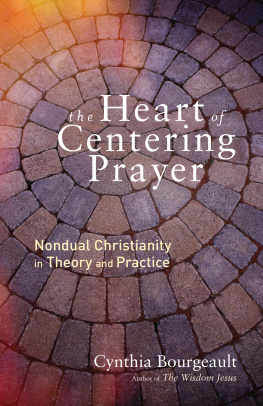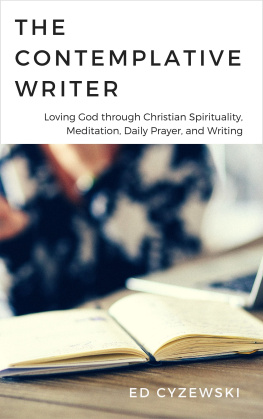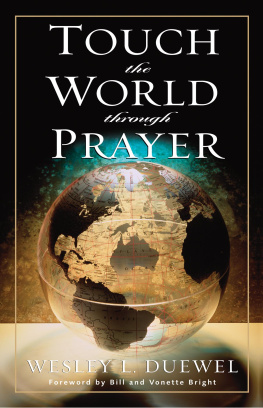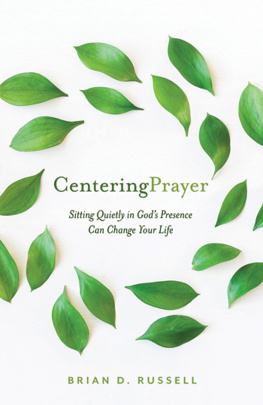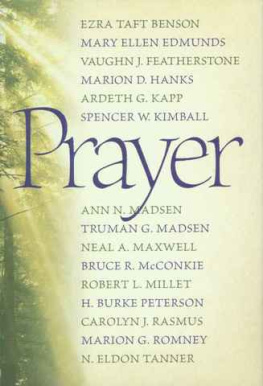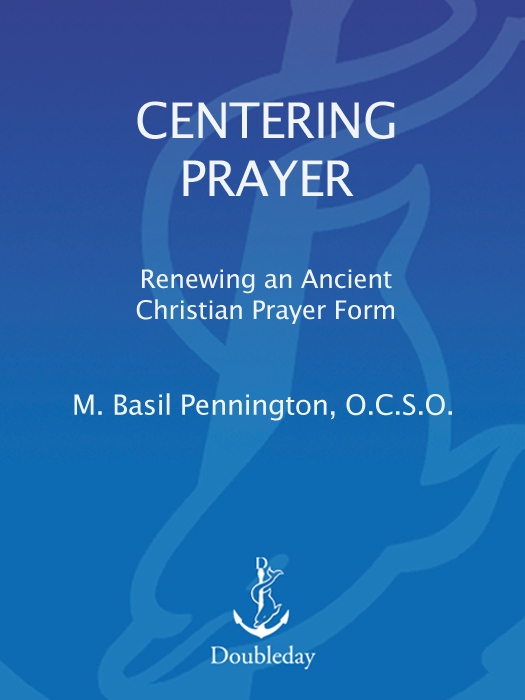OTHER BOOKS FROM M. BASIL PENNINGTON
Centered Living: The Way of Centering Prayer
The Bread of God: Nurturing a Eucharistic Imagination
A Place Apart: Monastic Prayer and Practice for Everyone
Call to the Center: The Gospels Invitation to Deeper Praye
True Self/False Self: Unmasking the Spirit Within
Living in the Question: Meditations in the Style of Lectio Divin
A School of Love: The Cistercian Way to Holines
Vatican II: Weve Only Just Begun
Why We Live in Community
Eucharist: Wing of Faith, Bread of Life
Daily We Touch Him: Practical Religious Experiences
Awake in the Spirit
Thomas Merton, My Brother: His Journey to Freedom,
Compassion and Final Integration
Daily We Follow Him: Learning Discipleship from Peter
Bernard of Clairvaux: A Lover Teaching the Way of Love
(Selected Spiritual Writings)
On Retreat with Thomas Merto
Listening Gods Word for Today
Monastic Journey to India
Thomas Merton, Brother Monk: The Quest for Freedom
Toward an Integrated Humanity: Thomas Mertons Journe
Through the Year with the Saints
Poetry as Prayer: The Psalms

To Dom M. Edmund Futterer, O.C.S.O.
Founder and first abbot of
Saint Josephs Abbey, Spencer
Propagator of the
Cistercian Order
in South America
A great and wise spiritual father
on the occasion of the
golden jubilee of his
monastic profession
192979
Out of his infinite glory,
may he give you the power through his Spirit
for your hidden self to grow strong,
so that Christ may live in your hearts through faith,
and then,
planted in love and built on love,
you will with all the saints have strength
to grasp the breadth and the length,
the height and the depth;
until, knowing the love of Christ,
which is beyond all knowledge,
you are filled with the utter fullness of God.
EP. 3:1619
C ONTENTS

I.
II.
III.
IV.
V.
VI.
VII.
VIII.
IX.
X.
XI.
XII.
XIII.
XIV.
P REFACE TO THE 2001 E DITION

IT IS DIFFICULT to believe that it is only twenty years since Centering Prayer was first published. They have been very full and fruitful years.
One of the wonders of the written word is that it can travel far and wide and reach people in all walks of life. I can remember the day I was climbing the mountains above Kathmandu in Nepal. As my Jesuit host and I made our way up the steep trail, we encountered a man coming down. He greeted us with a friendly smile. And then a look of recognition came into his eyes: I know you. With that he pulled a copy of Centering Prayer out of his sack.
There comes to mind another meeting. I was standing in front of St. Francis Assisi Church on Thirty-first Street in New York. As I waited for my friend, a rather disheveled gentleman approached me. I began to fish in my pocket for a dollar bill. Are you BasilBasil Pennington? I thought: This is going to be five dollars. When I nodded yes, he pulled a very battered copy of Centering Prayer from his pocket. This is great. We all use it. I just came from my meeting. It certainly has been one of my joys that this way of prayer has served the AA program well as they established Twelve-Step Groups.
It has not surprised me to see Centering Prayer rapidly find its place in the American Church. Centering Prayer is very much in the spirit of the renewal called forth by the Second Vatican Council. It looks to the Gospels: Come to me, all you who labor and are heavily burdened and I will refresh you (Matt. 11:28). And to the spirit and aims of our living tradition. If this way of prayer does not go back to Jesus himself and to Jewish tradition (and I believe it does), it certainly is found in the writings of our earliest spiritual fathers, East and West, Greek and Latin. And it has brought that tradition to today in a simple and practical way that responds to the signs of the times. Charismatic renewal opened us to seek the immediate experience of God. Methods of meditation, coming to us from Eastern traditions, opened us to seek an experience of the Power within. The time was certainly ripe for us to refind our own authentic tradition of contemplative prayer.
The very complicated and demanding methods of prayer and spirituality put together in the more rationalistic postTridentine Church created the impression that contemplative prayer was meant for only a chosen few. But the Spirit speaking through the Second Vatican Council reminded us forcefully that every Christian is called to enjoy contemplation and that deep union with God which we call holiness. Centering Prayer in its simplicity and directness has made it possible for the average Christian to move quickly and easily in this direction.
As I said, it did not surprise me that religious and lay folks in all parts of the United States began to show interest in this simple traditional way of prayer. In 1984 the Contemplative Outreach was established to support and give some supportive structure to this lay movement. At the same time, the Mastery Foundation was created to foster this contemplative dimension among the clergy and others whose lives are about sacred ministry. What has been more surprising has been the way Centering Prayer has spread around the world. Thanks to the vision, energy, and dedication of lay leaders, Centering Prayer moved quickly through countries like the Philippines and Malaysia, England and Ireland. Most striking was our experience in South Africa. Gandhi said if one percent of the people would meditate there would be peace. A wonderful woman, eighty years young, by the name of Winnie Young aimed at bringing Centering Prayer to one percent of her country and more. The result, a new phenomenon among the human family: Boards of Reconciliation rather than War Crimes Trials. Winnie is in her nineties now, but she still animates a vital Centering Prayer movement in her country.
Centering Prayer is indeed a living tradition. The simple method set forth in pastoral fashion by Abba Isaac in response to the fervent entreaties of Saint John Cassian and his companion received more nuance and detail as time went on. The abba of The Cloud of Unknowing would be more precise in regard to the method and insightful in his elaboration. In response to the pragmatism of our times, we first set forth the tradition in three simple rules. Even these have been somewhat altered in later usage:
Sit relaxed and quiet.
Be in faith and love to God who dwells in the center of your being.
Take up a love word and let it be gently present, supporting your being to God in faith-filled love.
Whenever you become aware of anything, simply, gently return to the Lord with the use of your prayer word.



